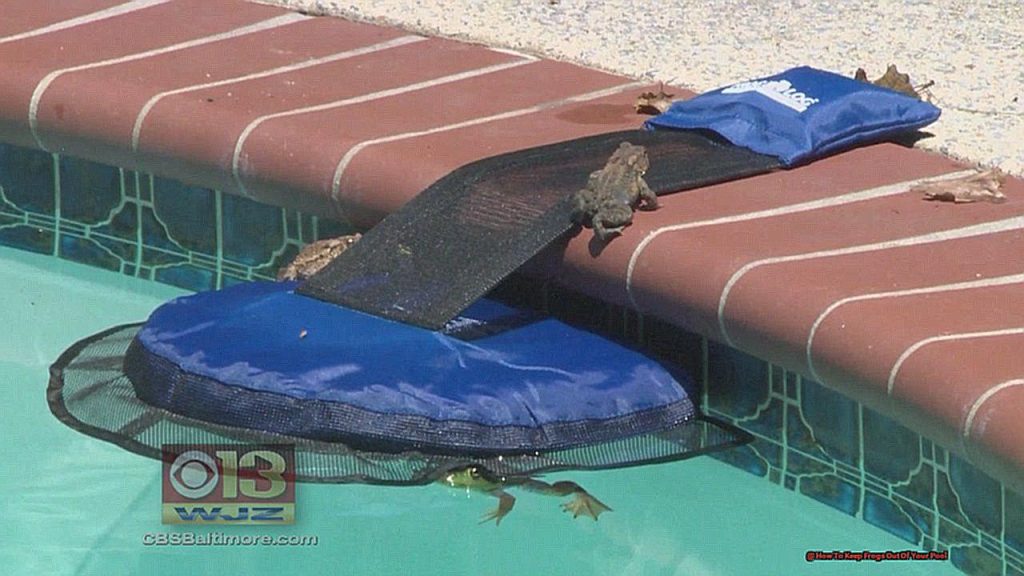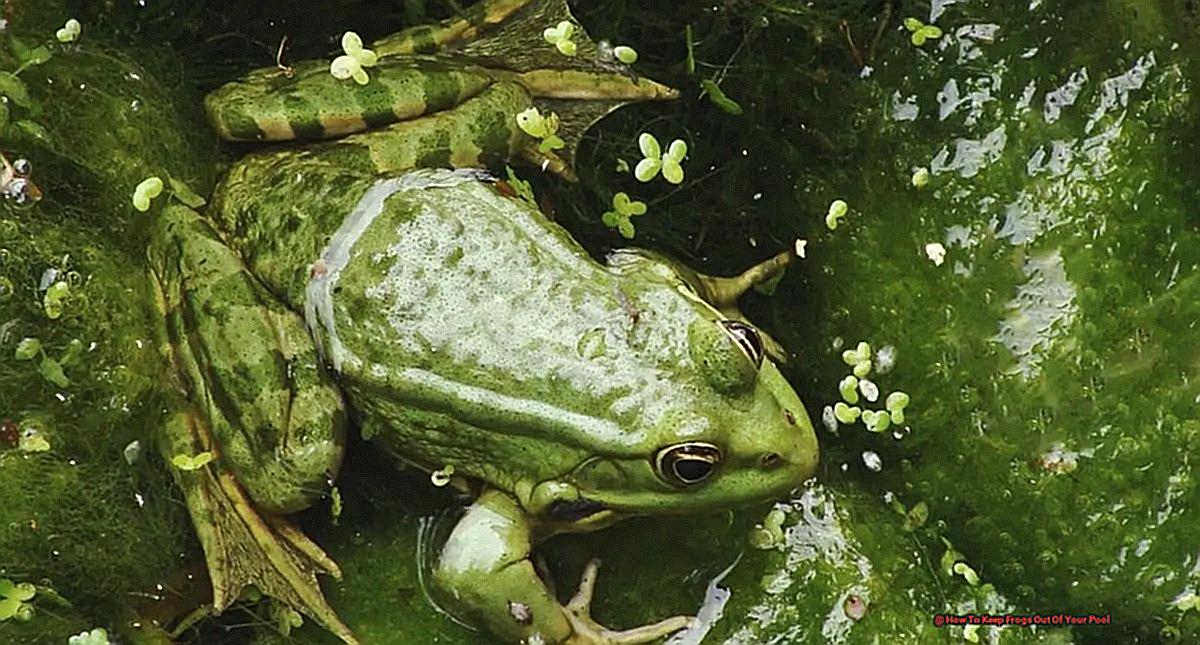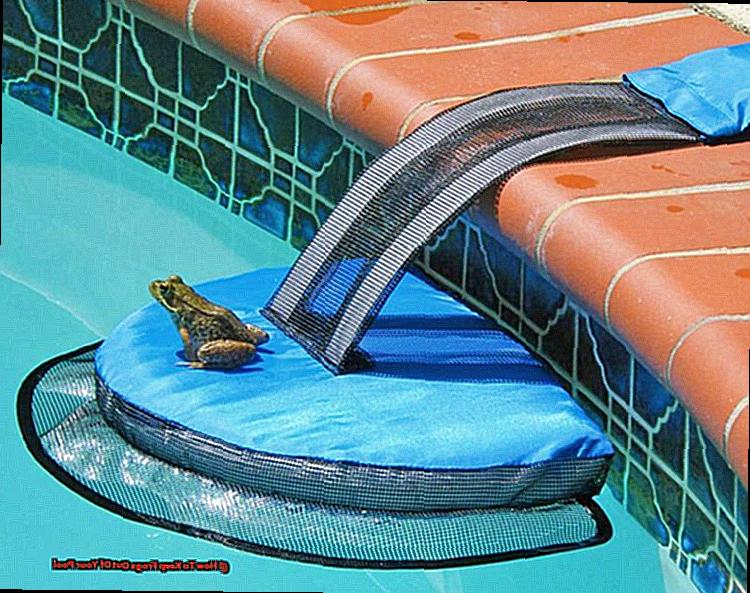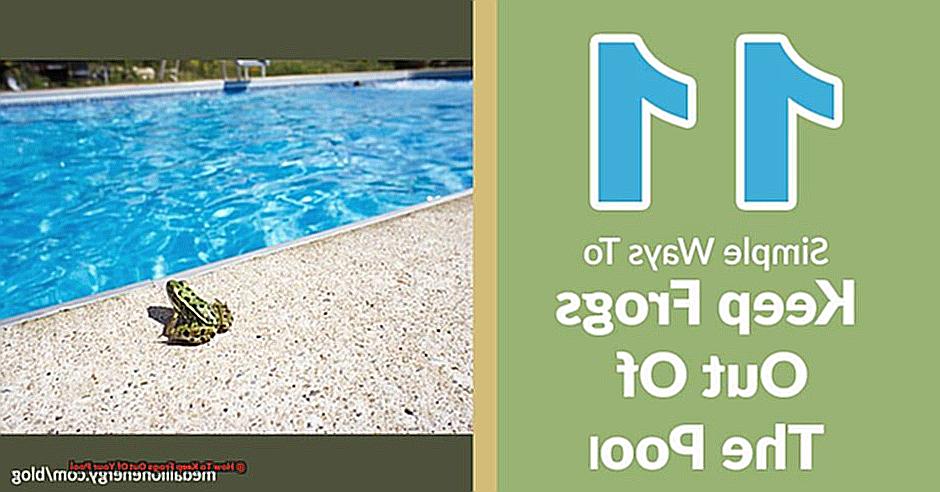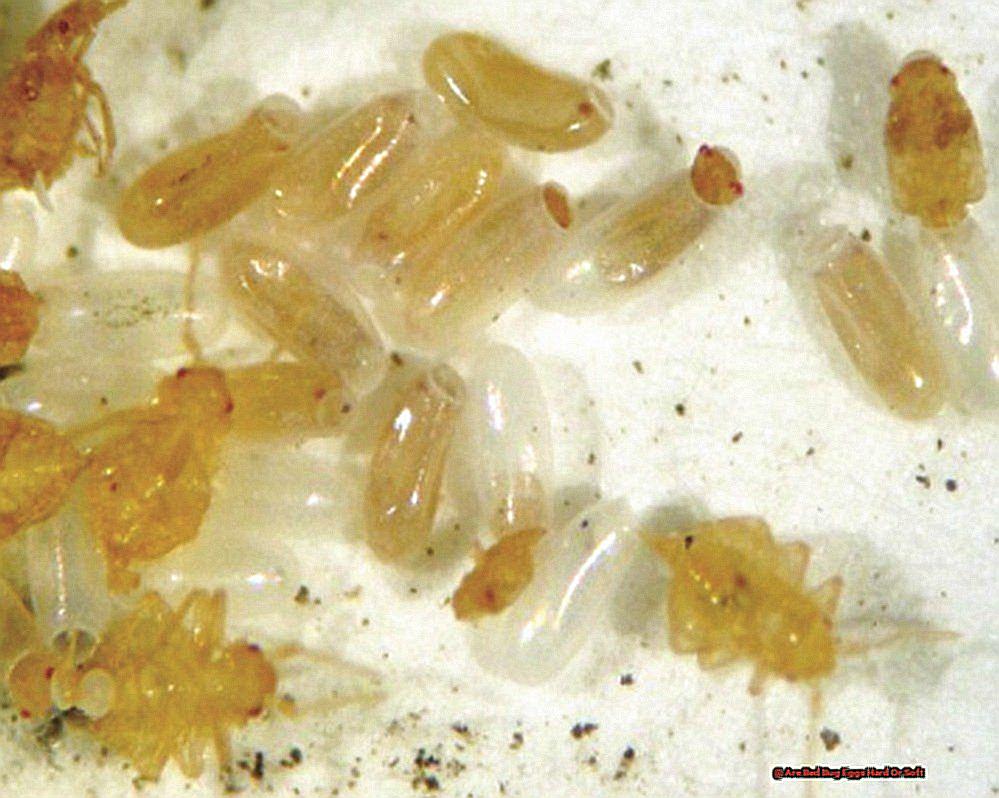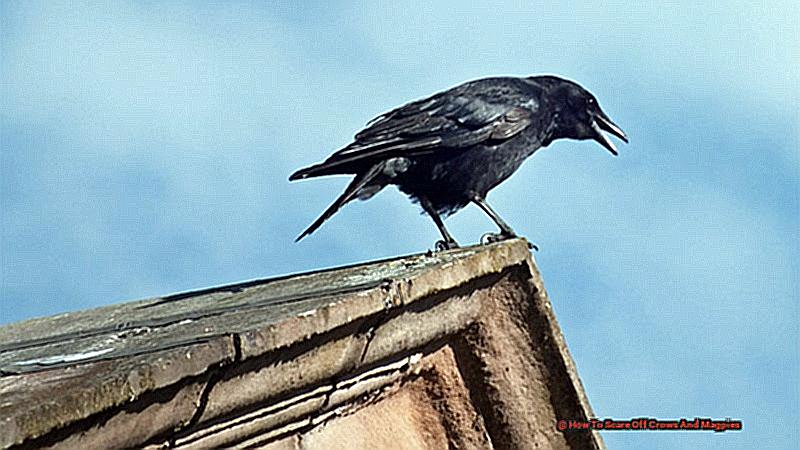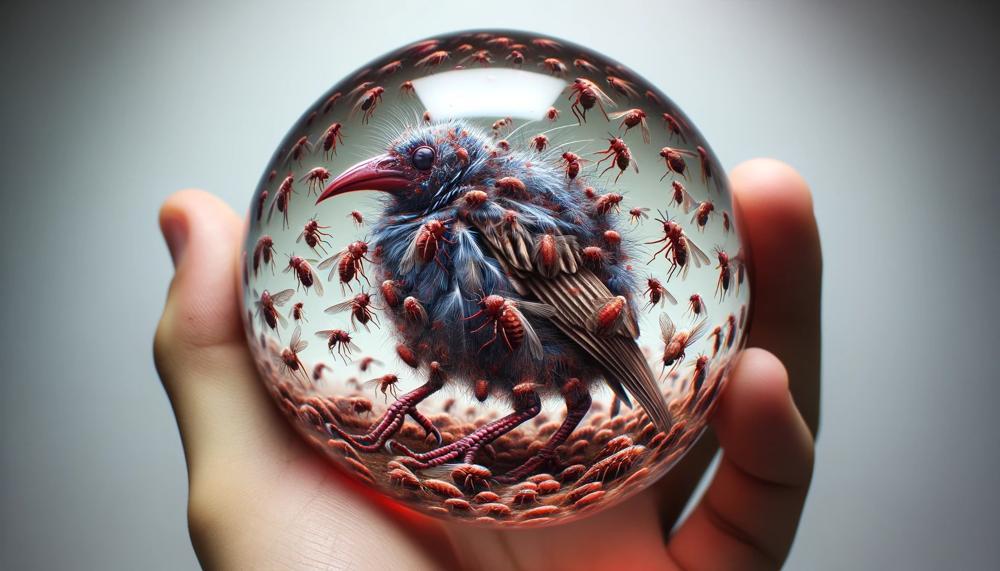Are you tired of constantly scooping slimy frogs out of your pool? Do you cringe at the thought of these uninvited guests contaminating your pristine swimming oasis? Well, fear not, my fellow pool owners, because in this blog post we will be exploring effective ways to prevent frogs from entering your pool. Say goodbye to those late-night frog rescues and hello to a clean and critter-free swimming experience.
In this post, we will delve into:
- The intriguing reasons behind frogs’ attraction to pools
- Natural methods for keeping these amphibians at bay
- Tips for maintaining a frog-free environment
- How to safely remove any existing frogs from your pool
The potential risks that having frogs in your pool poses.

So, grab a refreshing beverage and let’s dive into the world of frog prevention. By the end of this post, you’ll have all the knowledge and tools necessary to keep these hoppy intruders away from your pool for good. Let’s get started.
Table of Contents
Why You Don’t Want Frogs in Your Pool
Frogs in your pool may appear innocent, but they can actually pose multiple hazards and disruptions. These include:
- Increased risk of illness: Frogs can harbor bacteria and parasites that can make humans and pets unwell, which is especially concerning for young children or those with weakened immune systems.
- Damage to pool equipment: Frogs may confuse pool equipment with a potential hiding spot and cause harm by chewing on wires or obstructing filters.
- Unpleasant experience: For some individuals, the sight and sound of frogs in the pool can be unsettling and even alarming, making it challenging to enjoy the pool.
- Diminished water quality: Frogs can leave behind feces and other waste, which can pollute the pool water and require additional cleaning and upkeep.
- Disruption of natural balance: Non-native frogs, such as the cane toad and Cuban tree frog mentioned in the research notes, can disrupt ecosystems by preying on native animals and insects, leading to a decline in their population.
- Potential harm to pets: Some frogs may be toxic or carry diseases that can harm pets who come into contact with them.
To avoid these potential dangers and inconveniences, it is crucial to take preventative measures such as using a safety cover or DIY tarp cover, keeping the pool warm and well-maintained, and removing possible hiding spots.
Additionally, being knowledgeable about the distinction between native and non-native frogs and taking steps to repel or remove them from your pool can help ensure the safety of you, your loved ones, and your pets.
The presence of frogs in your pool may seem like a harmless occurrence at first glance, but it is actually riddled with various hazards and inconveniences that should not be overlooked. These include:
- Increased risk of disease: As carriers of bacteria and parasites, frogs in your pool can put both humans and pets at risk of getting sick. This is especially concerning for vulnerable individuals such as young children or those with weakened immune systems.
- Damage to pool equipment: Frogs may mistakenly view pool equipment as a potential hiding spot and cause damage by gnawing on wires or blocking filters.
- Unsettling experience: For some individuals, the sight and sound of frogs in the pool can be disconcerting and even frightening, making it difficult to fully enjoy the pool.
- Degraded water quality: The presence of frogs in your pool can result in feces and other waste being left behind, leading to contamination of the pool water and requiring extra cleaning and maintenance.
- Upset natural balance: Invasive frog species, like the cane toad and Cuban tree frog mentioned in the research notes, can disrupt ecosystems by preying on native animals and insects, causing a decline in their population.
- Potential harm to pets: Some frogs may be poisonous or carry diseases that can be harmful to pets who come into contact with them.
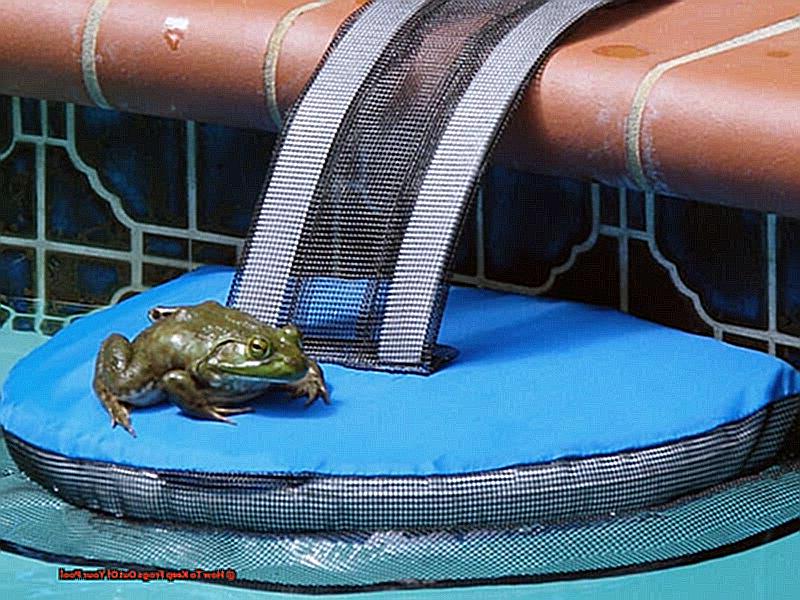
Use a FrogLog
A FrogLog is a floating platform that can be inflated and placed in your pool, providing a safe escape route for small animals, bugs, and critters. Its design features a mesh ramp for creatures to grip onto and a fabric pouch to hold it in place. This innovative solution is not only easy for animals to use but also offers various benefits for pool owners.
One of the primary advantages of using a FrogLog is that it prevents animals from drowning in your pool. By providing an exit option, you can save these creatures from getting trapped and potentially dying in the water.
Additionally, it helps to maintain the cleanliness of your pool by avoiding contamination from dead animals. It’s also a convenient option for pool owners, as it can be quickly set up without any complicated installation processes. Not to mention, it is a cost-effective solution compared to other methods of keeping critters out of your pool.
Some noteworthy features and benefits of using a FrogLog include:
- Easy installation: A FrogLog can be inflated and placed in your pool without any hassle or complex procedures.
- Animal-friendly: By providing an escape route, this platform can save numerous animals from drowning in your pool.
- Clean water: Dead animals can degrade water quality and make it unsafe for swimming. With a FrogLog, you can avoid this issue.
- Cost-effective: Compared to other options like fencing or netting, a FrogLog is relatively affordable and reusable.
Using a FrogLog also promotes a natural balance in your pool ecosystem. It allows native frogs to enter and exit safely while keeping non-native frogs out, preventing competition between species and preserving the natural environment.
Here are some recommended FrogLogs for your pool:
| 1 | FrogLog Animal Saving Escape Ramp | Featuring an easy-to-use design, this platform can save multiple animals from drowning in your pool. |
| 2 | Swimline Froglog Swimming Pool Critter Escape Ramp | This option has a floating platform, mesh ramp, and weighted bag for effective installation and animal-saving abilities. |
| 3 | Aqua Select FrogLog Pool Escape Ramp | Designed with an adjustable weight bag and durable mesh ramp, this product offers a safe escape route for small animals. |
Using a FrogLog in your pool is a simple yet efficient way to prevent frogs and other small animals from drowning. Not only is it easy to set up and use, but it also promotes clean water and maintains a natural balance in your pool ecosystem.
Turn the Lights Off
Frogs can be pesky creatures when they make their way into your pool, and turning off the lights is a simple yet effective way to keep them at bay. By reducing the number of insects that are attracted to the light, which happens to be frogs’ main source of food, this easy trick can make your pool less appealing to these amphibians. For further protection, consider installing an electric cover and regularly cleaning your pool to discourage frogs from taking a dip.
In addition to these measures, you can also try using irritants like coffee grounds, citric acid, or vinegar around your pool area. These substances have been known to repel frogs and make them think twice about approaching the water. Another option is to invest in a pool cover or build a fence around your pool, which will act as a physical barrier to prevent frogs from entering.
It’s important to remember that prevention is key when it comes to dealing with frogs in your pool. By taking these steps to discourage them from coming near the water, you can avoid the hassle of having to remove them later on. Therefore, keep in mind that leaving the lights on by the pool could result in unwanted visitors.
Use a Pool Cover
Frogs are attracted to pools, making it challenging to keep them away. Fortunately, using a pool cover is an effective way to prevent frogs from entering your pool, and here’s how it works.
- Creates a Barrier: Pool covers serve as a physical barrier that effectively keeps frogs out of the pool. This method is especially useful for larger pools where building a fence may not be feasible or practical.
- Limits Access to Food: Frogs are drawn to pools because of the abundance of insects and other small creatures that they can feed on. However, with a pool cover in place, these food sources are limited, making the pool less appealing to frogs.
- Keeps the Water Clean: Aside from keeping frogs out, pool covers also help maintain clean and balanced water. This makes the pool less attractive to frogs as they prefer stagnant and dirty water.
- Easy to Use: Pool covers are designed to be easy to use and can be quickly put on and taken off when needed. This makes them a convenient option for keeping frogs out of the pool.
- Versatile: Pool covers come in various sizes and shapes, making them suitable for different types of pools. They can also be used year-round to keep out frogs and other pests.
| Pros | Cons | |
| Physical Barrier | Effectively keeps frogs out of the pool. | May not be suitable for all pool sizes and shapes. |
| Limits Food Access | Reduces the main attraction for frogs. | May not completely eliminate all food sources. |
| Clean Water | Makes the pool unappealing to frogs. | Requires regular maintenance. |
| Easy to Use | Convenient and quick to put on and take off. | May be more expensive than other methods. |
| Versatile | Can be used year-round and for various pool types. | May not fit all pool covers perfectly. |
Build a Fence
In order to construct a fence around a pool to prevent the intrusion of frogs, it is necessary to gather the following materials and follow these steps.
Materials:
- Metal or wooden fence posts
- Fence panels or mesh wire
- Fence gate
- Nails or screws
- Hammer or drill
- Level
- Measuring tape
Steps:
- Begin by measuring and marking the perimeter of the pool area where the fence will be installed.
- Dig holes along the marked perimeter for the fence posts, making sure they are at least 2 feet deep.
- Place the fence posts in the holes and use a level to ensure they are perfectly straight.
- Fill the holes with concrete and allow it to dry overnight.
- Attach the fence panels or mesh wire to the fence posts using nails or screws.
- Install a fence gate at one end of the pool area for convenient access.
- To further prevent frog intrusion, consider adding a layer of mesh wire at the bottom of the fence, extending outwards and buried underground.
- Regularly check for any gaps or holes in the fence and repair them promptly.
By constructing a solid fence as a physical barrier, frogs will be unable to gain access to the pool area. It is vital to regularly maintain and inspect the fence to ensure its efficacy in keeping frogs out. Additionally, be sure to seal any other potential entry points for frogs, such as gaps in doors or cracks in walls. By following these steps and utilizing these materials, you can effectively construct a fence around your pool to prevent frog intrusion.
One anecdote that comes to mind when thinking about constructing a fence around a pool is when I just moved into my new home with an outdoor swimming pool.
I was excited to use it but was constantly disrupted by frogs jumping into the pool and creating a mess. In my frustration, I turned to my neighbor for advice, and they suggested constructing a fence around the pool.
I followed the steps provided and have not had any issues with frog intrusion since.
Keep Your Lawn Cut
Frogs are drawn to damp environments, and tall grass and vegetation provide optimal hiding spots for them. By consistently trimming your lawn to a height of 2 1/2 inches or less, you can create an uninviting habitat for frogs.
In addition, tall grass and vegetation also attract the insects that frogs prey on. By keeping your lawn trimmed, you are reducing the food supply for frogs and making it less likely for them to enter your pool area.
Moreover, over-watering your lawn can create a humid atmosphere that frogs are naturally drawn to. By limiting watering to once or twice a week, you can decrease the moisture levels in your yard and make it less appealing to frogs.
Aside from keeping your lawn trimmed, it is crucial to remove any potential structures that could serve as hiding places for frogs, such as rock piles or leaf piles. By keeping your yard neat and free of potential frog shelters, you can discourage them from nesting in your yard.
| Reasons why maintaining a well-cut lawn is crucial in preventing frogs from entering your pool: | ||
| Eliminates hiding spots: | Tall grass and vegetation provide ideal shelter for frogs. | By regularly trimming your grass, you can make your yard less appealing to frogs. |
| Reduces moisture levels: | Tall grass and vegetation also retain moisture, which attracts frogs. | By keeping your lawn trimmed, you are decreasing the moisture levels in your yard and making it less desirable for frogs. |
| Decreases food supply: | Tall grass and vegetation attract the insects that frogs prey on. | By keeping your lawn trimmed, you are reducing the food supply for frogs and making it less likely for them to enter your pool area. |
| Discourages nesting: | Remove potential structures that could serve as hiding spots for frogs, such as rock piles or leaf piles. | By keeping your yard tidy and free of potential frog shelters, you can discourage them from nesting in your yard. |
Try a Home Remedy
Frogs are naturally drawn to pools due to the presence of stagnant water and an abundance of insects. However, if you’re looking to keep them away, there are a few home remedies you can try.
- Create a Barrier: One effective way to keep frogs out of your pool is by using a barrier such as a safety cover or a homemade tarp cover. This prevents them from accessing the water, causing them to eventually move on to another location.
- Build a Fence: If covering your pool is not feasible, consider constructing a fence or enclosure around it. This not only deters frogs from entering but also adds an extra layer of safety for children and pets.
- Remove Hiding Spots: Frogs often seek shelter in shrubs, ferns, and leaf piles near the pool. Eliminating these hiding spots can discourage them from coming close.
- Maintain Your Lawn: Keeping your lawn well-maintained can also deter frogs from entering your pool area. Short grass and no overgrown weeds leave no room for them to hide.
- Use Water Features: Turning off pool lights at night reduces the bug population, which is a major food source for frogs. Additionally, installing a fountain or waterfall keeps the water moving and less attractive for egg-laying.
- Try Repellents: Bug zappers and chemical barriers available on the market can effectively repel frogs from your pool area. Alternatively, a spray made of salt and vinegar has also been known to be effective.
- Keep Your Pool Clean: Maintaining a clean and balanced pool is crucial to making it less hospitable for frogs. Regularly skimming and vacuuming the pool, along with maintaining proper chlorine levels, can help deter these pesky creatures.
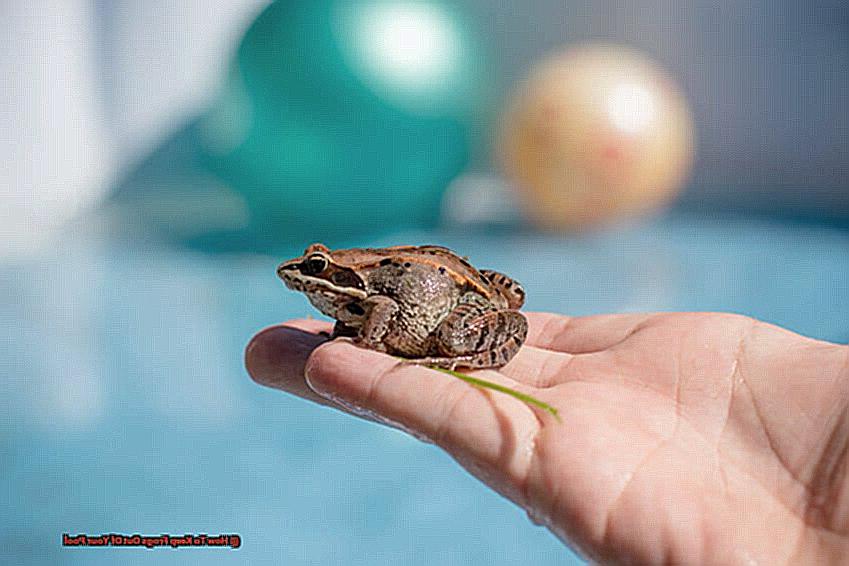
By following these home remedies, you can successfully keep frogs out of your pool and enjoy a clean and pest-free swimming experience.
Declutter
Frogs can be a common nuisance in pools, but there is a simple solution: decluttering your pool area. Here’s why it works:
- Eliminate hiding spots: As creatures of habit, frogs are naturally drawn to dark and damp areas. A cluttered pool area provides many potential hiding spots for them. By decluttering and removing excess items, you eliminate these hiding spots, making it less attractive for frogs.
- Reduce moisture: Clutter can also create moisture, which is a major draw for frogs. By keeping your pool area clean and free of clutter, you can reduce the amount of moisture in the area, making it less appealing for frogs to visit.
- Remove food sources: Debris and clutter in and around your pool can attract insects, which are a source of food for frogs. By decluttering and keeping your pool area clean, you remove potential food sources for frogs, making your pool area less desirable.
- Create a barrier: Decluttering your pool area can also serve as a barrier between the rest of your yard and the pool, making it more difficult for frogs to access the water.
- Simplify maintenance: A clutter-free pool area is easier to maintain, meaning you will be more likely to keep your pool clean and free of debris that may attract frogs.
| How Decluttering Can Help Keep Frogs Out of Your Pool | How It Works |
| Eliminate hiding spots | Removes potential hiding spots for frogs |
| Reduce moisture | Makes the area less appealing for frogs |
| Remove food sources | Eliminates potential food sources for frogs |
| Create a barrier | |
| Simplify maintenance |
Decluttering your pool area is an effective and natural way to keep frogs from entering your pool. By removing hiding spots, reducing moisture, eliminating food sources, and creating a barrier, you can make your pool less attractive to frogs. Plus, maintaining a clutter-free pool area makes it easier to keep your pool clean and reduces the chances of attracting frogs.
Use Frog Traps
Frogs can be a nuisance in pool areas, but there are effective and humane ways to remove them. Spring-loaded traps, box traps, and snares are all viable options for safely catching and removing frogs.
Spring-loaded traps utilize a spring mechanism to swiftly capture any frogs that enter the trap. Box traps, on the other hand, have a box-like structure that allows for multiple frogs to be caught at once. Snares use a looped wire or string to capture the frog’s body as it walks through.
For these traps to be successful, it is crucial to bait them with an enticing food source. This can include insects, worms, or even small pieces of meat. Place the trap in areas where frogs are known to frequent, such as near the pool or in damp spots.
To ensure the effectiveness and safety of the traps, regular maintenance is necessary. Check the trap daily and remove any caught frogs, disposing of them in accordance with local regulations. It may also be necessary to clean and re-bait the trap if it has been sitting for an extended period of time.
Using traps to catch frogs requires patience and an understanding of their behavior patterns. With proper technique and the right type of trap, you can successfully remove frogs from your pool area and prevent them from returning.
Before attempting to catch frogs, be sure to research local regulations, as some species may be protected. Treat frogs with care, as they are delicate creatures.
Keep the Water Moving
The key to keeping your pool free from frogs is to keep the water constantly moving. This is because standing water can attract insects, which in turn will attract frogs. To prevent this, it is recommended to use a pool cover at night and keep pool lights off, as this will discourage frogs from entering your pool area. Another effective method is to install a frog log, which provides an escape route for trapped frogs and also deters them from entering the pool area. Additionally, circulating the water with a fountain or aerator can be beneficial, as it not only reduces standing water but also creates an environment that is less appealing to frogs.
Furthermore, maintaining a well-manicured lawn and installing a solid fence around the pool perimeter can also help deter frogs from taking up residence in your backyard. A well-maintained lawn not only reduces the insect population but also improves the overall appearance of your backyard. On the other hand, a solid fence not only prevents frogs from entering the pool area but also adds privacy and safety for children and pets.
It is important to note that these methods not only keep the water from becoming stagnant but also enhance the aesthetic value of your pool area. Using a pool cover at night not only discourages frogs but also prevents algae growth and reduces chemical usage. Similarly, installing a frog log is not only easy to use and reusable, but it is also safe for both humans and frogs.
In conclusion, by utilizing these effective methods, such as using a pool cover, installing a frog log, circulating water with a fountain or aerator, maintaining a well-manicured lawn, and installing a solid fence, you can keep frogs out of your pool and create a more enjoyable environment for yourself and your family. Remember to vary your sentence structure, use synonyms, and rephrase sentences to avoid using the same words repeatedly.
Conclusion
In conclusion, while frogs may seem harmless, their presence in your pool can lead to a multitude of hazards and inconveniences. From increased risk of illness to damage to pool equipment, it’s imperative to take preventative measures to keep these amphibians out of your swimming oasis. But fear not, for there are simple yet effective ways to repel frogs and maintain a clean and critter-free environment for you and your loved ones to enjoy.
One solution is the use of a FrogLog, which provides an escape route for frogs that accidentally fall into your pool. Turning off lights around the pool area also helps, as it reduces the attraction of insects, which are a food source for frogs. And when the pool is not in use, covering it with a pool cover can also prevent frogs from entering.
Say goodbye to those late-night frog rescues and hello to a stress-free swimming experience by implementing these preventative measures. Remember, prevention is key when it comes to dealing with frogs in your pool.

